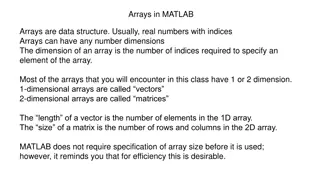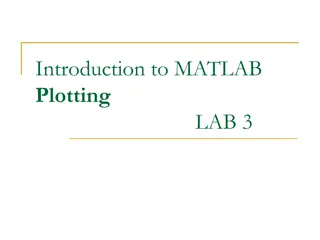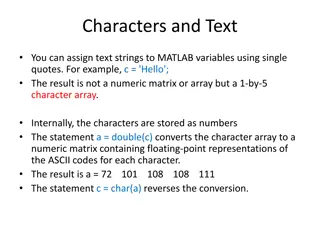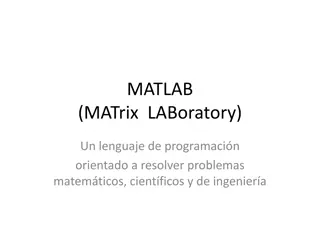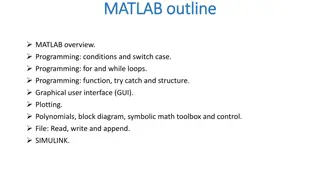
Learn MATLAB Basics: Matrices, Operations, and Demos
Discover the fundamentals of MATLAB, including matrix indexing, matrix operations, and various demos. Explore how to define matrices, create equally spaced vectors, and perform operations using built-in functions. Dive into the world of MATLAB with this comprehensive guide.
Download Presentation

Please find below an Image/Link to download the presentation.
The content on the website is provided AS IS for your information and personal use only. It may not be sold, licensed, or shared on other websites without obtaining consent from the author. If you encounter any issues during the download, it is possible that the publisher has removed the file from their server.
You are allowed to download the files provided on this website for personal or commercial use, subject to the condition that they are used lawfully. All files are the property of their respective owners.
The content on the website is provided AS IS for your information and personal use only. It may not be sold, licensed, or shared on other websites without obtaining consent from the author.
E N D
Presentation Transcript
Introduction to MATLAB CS534 Fall 2016
What you'll be learning today MATLAB basics (debugging, IDE) Operators Matrix indexing Image I/O Image display, plotting A lot of demos ...
What is a matrix? 5 3 4 3 6 8 1x3 vector 3x1 vector 1 2 3 4 5 6 MxNxP matrix 2x3 matrix Terms: row, column, element, dimension
How are the dimensions arranged Second dimension 1 2 3 4 5 6 First dimension MxNxP matrix
Defining a matrix with literals >> A = [1 2 3; 4 5 6] semicolon separates rows A = 1 2 3 4 5 6
Defining a equally spaced vector >> A = 1 : 5 A = 1 2 3 4 5 >> A = 1 : 2 : 10 A = 1 3 5 7 9 start value end value (inclusive) increment Colon creates regularly spaced vectors Bonus: what if I have something impossible like A = -1 : 2 :-5
Define matrix with built-in functions zeros(M,N) ones(M,N) true(M,N) false(M,N) rand(M,N) Create matrices with all 0/1/true/false s M, N are number of rows and cols respectively can have more dims linspace(start, end, number) Create linearly spaced vector ranging from start to end (inclusive) number specifies the length of the vector Bonus: How do you get a matrix of all 5?
1 2 3 4 5 6 size() >> A = [1 2 3; 4 5 6]; >> size(A, 1) ans = 2 >> size(A, 2) ans = 3 A asks for first dimension asks for second dimension
1 2 3 4 5 6 size() cont'd >> A = [1 2 3; 4 5 6]; >> [height, width] = size(A) height = 2 width = 3 A
Concatenation M = [A, B; C, D] ; mark the next row B A 1 2 3 4 5 6 C 1 2 4 5 D 1 2 3 1 2 Dimension must match
Concatenation in higher dims cat(A, B, n) Operand matrices Dimension to work on The length of dimensions other than n of A and B must match
Linear Algebraic Operations Addition (dimensions match exactly) + - * ^ ' \ / Subtraction (dimensions match exactly) Matrix Multiplication (MxN-matrix * NxP-matrix) Matrix Power (must be square matrix) Transpose Left Matrix Division (Solves A*x=B) Right Matrix Division (Solves x*A=B)
How Operations Work 1 2 3 4 3 1 5 6 A = B = 4 3 8 10 -2 1 -2 -2 A+B = A-B = 13 13 29 27 7 10 15 22 A*B = A^2 = -1 4 2 1.5 -.3077 .3846 .1538 .6923 A\B = B/A = solves A*x = B solves x*A = B
Transpose 1 3 5 7 9 11 13 15 C = 1 5 9 13 3 7 11 15 C =
Elementwise Operations dimensions need to match exactly usually use . to distinguish from their linear-algebraic counterparts Addition Subtraction Element by Element Multiplication Element by Element Division Element by Element Power A.^2 vs. A^2 vs. A.^B + - .* ./ .^
Element-wise operations 1 2 3 4 Note the 2 operand matrix for element-wise operations must match 3 1 5 6 A = B = .333 2 .6 .666 A ./ B = 3 2 15 24 A .* B = 1 2 243 4096 1 4 9 16 A .^ B = A .^ 2 =
Logical operators is equal to == < > <= >= ~ ~= & matrices) | ~ To be distinguished from && expressions) || expressions) less/greater than not not equal to elementwise logical AND (for elementwise OR (for matrices) negation short-circuit AND (for logical short-circuit OR (for logical
Two useful commands all() any() both work along one dimension of the matrix by default compare along first dimension use an optional second parameter to specify the dimension to work on help to shrink a logical matrix to a logical scalar then you can use || or &&
1 2 3 4 5 6 Accessing a single element A(2, 3) Element on 2nd row, 3rd column Note: indexing starts from 1, not zero!
1 2 3 4 5 6 Block Indexing A([1,2], [1,3]) Can use vectors to index block of elements A([2,2],[1,2,3]) Duplicate second row A([1,2], [3,2,1]) A([1,2], 3:-1:1) Change col orders
1 2 3 4 5 6 Indexing entire row/col : represent the entire of that dimension A(2, :) Returns 2nd row A(:, [1,3]) Returns 1st, 3rd column in a matrix
1 2 3 4 5 6 end operator end represent the last of that dimension >> A = [1 2 3; 4 5 6]; >> A(:, end:-1:1) ans = 3 2 6 5 1 4 Reverse the col orders
1 2 3 4 5 6 end operator >> A = [1 2 3; 4 5 6]; >> A(:, [1 end 1]) ans = 1 3 1 4 6 4 Returns concatenation of 1st, last and 1st column
Indexing rules apply to 3D matrices too A(2, 4, 3) Element on 2nd row, 4th column of the 3rd channel 1 4 2 8 3 7 9 1 4 5 6 3
Logical Indexing Dimension of A and B must match 1 0 1 0 0 1 1 2 3 4 5 6 B A >>A(B) ans = 1 3 6 Select the element in A where B is true and put them in a column vector
Linear indexing Indexes an element in a matrix with a single number/vector, in column-major order. 11 45 23 21 89 59 A = Bonus: What will A(:) be?
Element Assignment You can also index a matrix to assign values to its elements With scalar RHS, it s easy A(1:2:end, 2:2:end) = 0 With matrix RHS, a little trickier A(1:2:end, 2:2:end) = A(1:2:end, 2:2:end)*2 The dimension of the RHS must match the indexed block With empty matrix RHS, it s a deletion A(2,:) = [] You can only index whole row/col and delete them
Statistic functions can operate on the whole matrix sum mean max min median std var By default they return col-wise statistics use a second param to indicate the dimension to operate on
Vectorized code tends to be faster than non-vectorized code A = rand(1000,1000); B = rand(1000,1000); for i = 1:size(A,1), for j = 1:size(A,2), C(i,j) = A(i,j) + B(i,j); end end Using loop: Elapsed time is 1.125289 seconds.
Vectorized code tends to be faster than non-vectorized code C = A + B; Elapsed time is 0.002346 seconds.
Question: What's the sum of all elements greater than 2 in A? 1 2 3 4 5 6 summation = 0; [height, width] = size(A); for j = 1 : height for i = 1 : width if A(j, i) > 2 summation=summation+A(j, i); end end end
Question: What's the sum of all elements greater than 2 in A? 1 2 3 4 5 6 summation = sum( A (A > 2) ); 0 0 1 1 1 1 T 3 4 5 6 18
1 2 3 4 5 6 A closer look at sum(A(A>2)) A > 2 returns logical matrix [ 0 0 1; 1 1 A([0 0 1; 1 1 1])returns column vector [3 4 5 6] sum([3 4 5 6] ) 1]
More Examples Logical indexing on the right-hand side count = sum(2 < A | A == 5); ave = mean(A(mod(A, 2) == 0)); Logical indexing with assignment A(isnan(A)) = 0;
What is an image? 236 252 255 24 72 78 An RGB image is a 3D MxNx3 matrix


